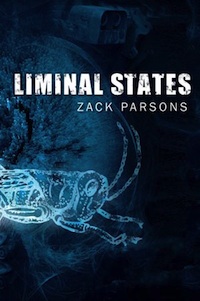Look, up on the shelf! It’s a western. It’s noir. It’s science fiction. It’s all three, blended together in Zack Parsons’ brilliant novel, Liminal States, and it’s super, man.
There are some novels that come along that just manage to push all one’s buttons. Liminal States was that for me. So I’ll warn you that this might be a little biased to those who like westerns, noir, and dystopian/apocalyptic fiction in their SF.
Liminal States is really a novel in three distinct parts, each one a different genre, each one focusing (mostly) on different characters. But also the same. It’s a bit complicated.
The story begins in 1874, in the west, in a town called Spark, New Mexico. We first meet Gideon Long, a rich young man, abused and despised by his father. Gideon is a schemer, and has a plan to make him rich and independent. This scheme brings him into conflict with Sheriff Warren Groves, a self-professed killer, but now a lawman. Groves is a much simpler man, more direct. Straightforward.
Unbeknownst to Groves, he and Gideon are joined through his wife, Annie Groves, whom they both love. Annie has married Warren, but has her doubts. She thinks she might be in love with Gideon, though she is now pregnant with Warren’s child.
Gideon plans a train robbery that sets into motion events that will play out for over a hundred years. The robbery goes terribly wrong, and Warren stops Gideon, shooting him in the stomach and sending him running off into the desert.
Gideon, dying, stumbles upon a strange Pool hidden in a deserted Pueblo village. I won’t spoil the novel by telling you what happens with the Pool, but this begins a sequence of events that will spiral out to affect the whole world, passing through decade after decade. Through the use of the Pool, Gideon survives, and begins a dance with Warren Groves that spans the rest of their natural lives and beyond.
In fact, their ultimate quarrel, and their love for the same woman, spills over to their descendants through time. One of these is Casper Cord and we pick up with him in 1951 in what is a pitch perfect noir story akin to Chandler. Here the tale switches to the first person (and rightly so) as Casper unravels the mystery of a dead woman who looks almost exactly like Annie Groves. In typical noir fashion, Casper is continually beaten and brought low before finally figuring out what’s going on. His discoveries shed light on some of the things that have come before and directly affect what comes afterward.
After a couple of skips through time, we come at last to the last third of the book which takes place in 2006 and shows us the ultimate result of the actions in the first two thirds of the novel. We move into alternate history, the events of previous years clearly changing the world, steering us firmly into horror. Disease is running rampant in this 2006 and LA has become something of an apocalyptic city. The world feels tenuous, and chaos swells like a bubble, just waiting to be popped. Navigating this world is Polly Foster, another descendant of our original three, trying to do the right thing, working for the establishment, but trying to follow her conscience.
If anything, I found the last third the weakest of the parts. It does deliver on everything that came before, but it plays out very much like a movie. And while that’s not inherently a bad thing, I found myself fatigued by disaster after disaster, action sequence after action sequence. Your mileage may vary, but I was more intrigued by the mysteries and the interpersonal relationships than the spectacle of the world falling apart. I suspect that this is probably a personal thing, though. Those bored by westerns would find the start of the book more tedious, and might well enjoy the unbridled momentum of the climax.
Without spoiling the central plot device, I will say that Parsons takes this idea and sees it through to all its inevitable outcomes. What at first seems like a wondrous and benign thing suddenly becomes horrific and chaotic, even as people try to harness and control it.
Parsons does a great job with the writing here, too. While he might benefit from a bit of restraint, much of his prose is just lovely. And while I was at first worried by the woodenness of some of the early sections, I soon discovered that he evokes the genres he’s writing in—inhabiting the western in the first part of the book, switching to the more iconic first person noir voice later. Some parts conjured up comparisons to China Mieville, though Parsons, on the whole, is easier to read (and American). Also impressive was Parsons’ ability to squick me out in a couple of places, a task that’s not easy to do. He can switch from the sublime to the grotesque quite easily.
A description I read of the book said that it shouldn’t work as a whole, and there is the sense of that, being separated into such distinct parts, but it does come together and at no time in the story did I feel like I knew where it was going. In fact, in the end it was a much more human story than I was expecting, and while that departed from my earliest assumptions, it was perhaps more satisfying.
With Liminal States, Zack Parsons establishes himself as an exciting and compelling new writer. I heartily recommend Liminal States, especially if a mashup of westerns and noir and dystopian horror is something that appeals to you. I look forward to whatever he does next.
Rajan Khanna is a writer, narrator, blogger and a fan of both westerns and hard-boiled crime fiction. His website is www.rajankhanna.com










